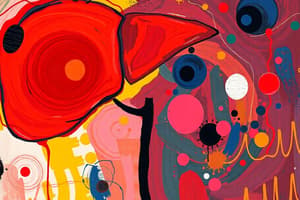Podcast
Questions and Answers
What is characteristic of patients with unconjugated hyperbilirubinaemia?
What is characteristic of patients with unconjugated hyperbilirubinaemia?
- Absence of bilirubinuria (correct)
- Increased conjugated bilirubin in plasma
- Dark urine
- Presence of bilirubinuria
Which of the following statements about conjugated bilirubin is true?
Which of the following statements about conjugated bilirubin is true?
- It is not broken down by bacteria in the gut
- It is not excreted in the urine
- It is fat-soluble
- It is less strongly protein-bound than unconjugated bilirubin (correct)
In most cases of jaundice in adults, which of the following is true?
In most cases of jaundice in adults, which of the following is true?
- Only conjugated bilirubin is increased in plasma
- Both conjugated and unconjugated bilirubin are increased in plasma, with unconjugated bilirubin predominating
- Both conjugated and unconjugated bilirubin are increased in plasma, with conjugated bilirubin predominating (correct)
- Only unconjugated bilirubin is increased in plasma
What is the term for the group of products formed by the breakdown of conjugated bilirubin in the gut?
What is the term for the group of products formed by the breakdown of conjugated bilirubin in the gut?
What is the fate of most of the urobilinogen formed in the gut?
What is the fate of most of the urobilinogen formed in the gut?
Flashcards are hidden until you start studying
Study Notes
Bilirubin Metabolism and Jaundice
- Jaundice becomes clinically apparent when the plasma bilirubin concentration reaches about 50 μmol/L (hyperbilirubinaemia).
Causes of Jaundice
- Jaundice occurs when bilirubin production exceeds the hepatic capacity to excrete it.
- Possible causes of jaundice include:
- Increased rate of bilirubin production exceeding normal excretory capacity of the liver (prehepatic jaundice).
- Damaged liver cells unable to conjugate and/or excrete bilirubin (hepatic jaundice).
- Obstruction of biliary flow, resulting in conjugated bilirubin being regurgitated into the systemic circulation (post-hepatic jaundice).
Unconjugated Hyperbilirubinemia
- Occurs when there is a marked increase in bilirubin load due to:
- Haemolysis or breakdown of large amounts of blood after haemorrhage.
- Impaired binding of bilirubin to ligandin or impaired conjugation with glucuronate in the liver.
- Unbound, unconjugated bilirubin can damage brain cells (kernicterus).
Conjugated Bilirubinemia
- One of the earliest signs of impaired hepatic excretion.
- Conjugated bilirubin is water-soluble and less strongly protein-bound than unconjugated bilirubin.
- Can be excreted in the urine, causing bilirubinuria.
Enzymes and Metabolism
- Bilirubin is conjugated with glucuronate in the liver.
- Stercobilinogen is formed from conjugated bilirubin in the gut lumen.
- Some stercobilinogen is absorbed into the portal circulation and re-excreted in bile (enterohepatic circulation).
- A small amount enters the systemic circulation and is excreted in the urine as urobilinogen.
Studying That Suits You
Use AI to generate personalized quizzes and flashcards to suit your learning preferences.




